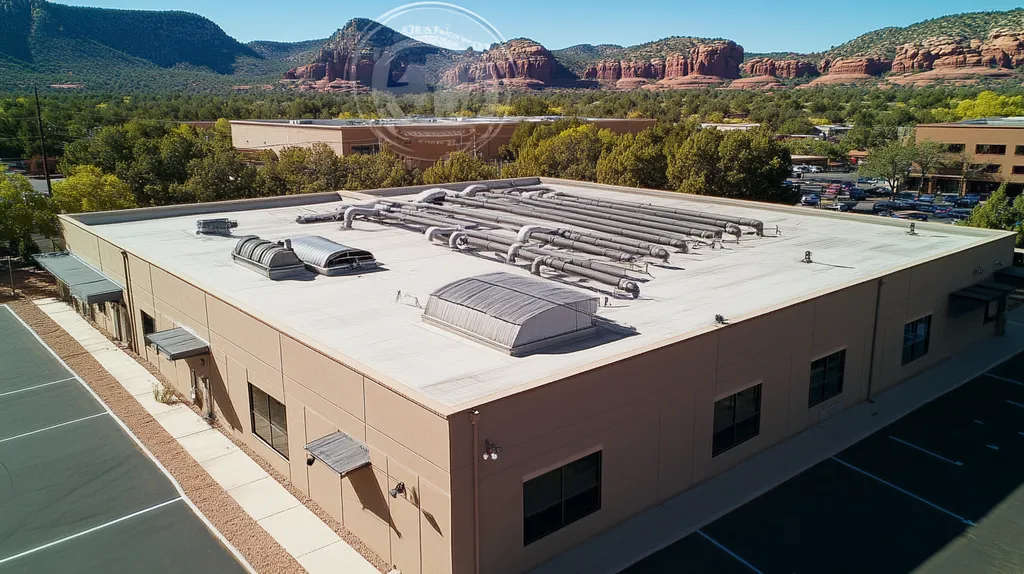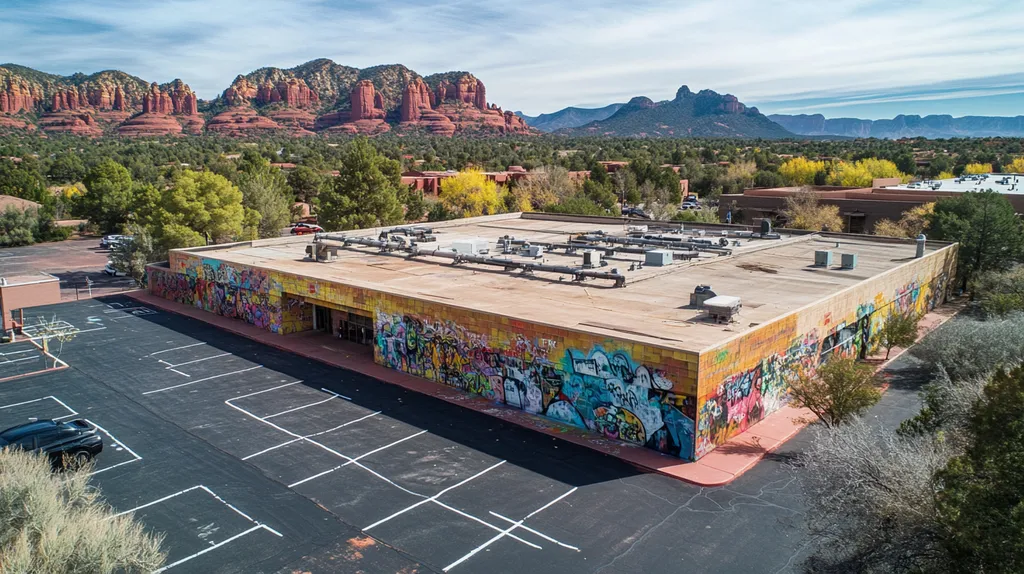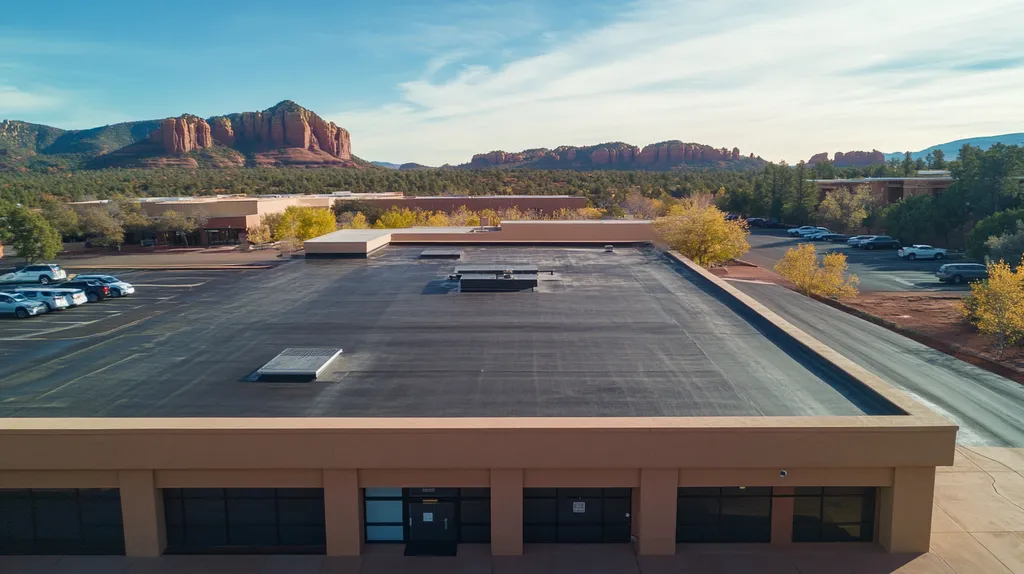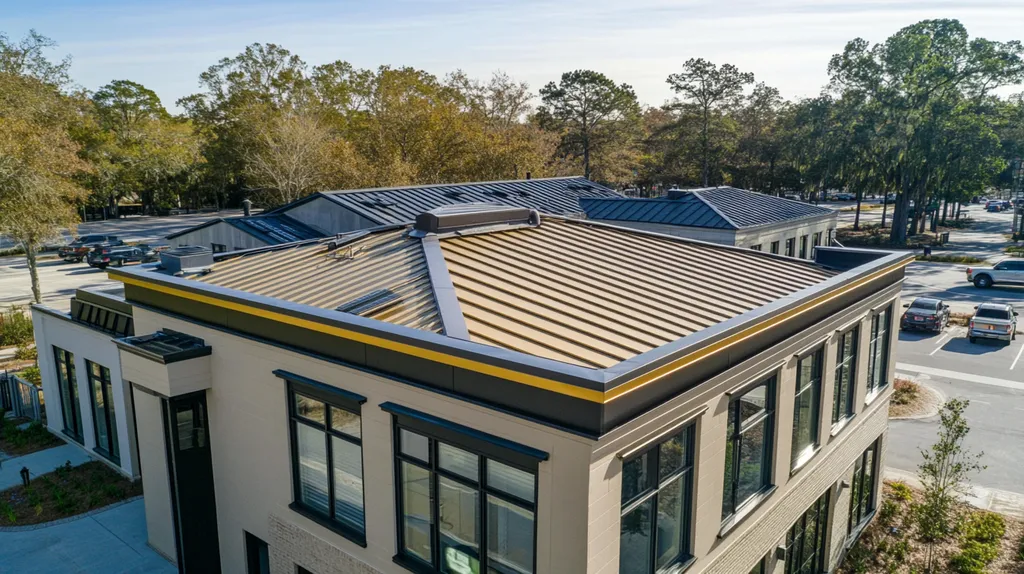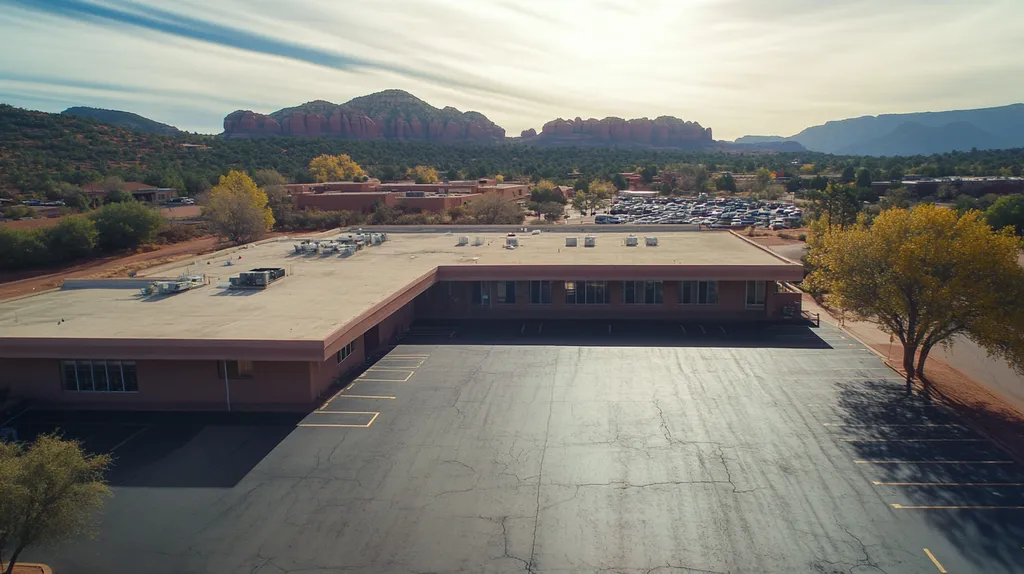Commercial roof coatings are failing at an alarming rate under extreme temperature conditions, with studies showing deterioration in up to 40% of installations within just three years of application.
As climate patterns become more erratic, traditional performance standards for roofing materials prove increasingly inadequate, exposing property owners to significant risks and unexpected costs.
This analysis examines the systemic issues plaguing current coating technologies, from thermal shock damage to energy inefficiency, while exploring how outdated testing protocols and maintenance practices compound these challenges.
SECTION 1: CURRENT PRACTICES
As climate conditions become increasingly erratic, the demand for effective roofing solutions has never been more pressing. Standard roofing materials frequently falter when confronted with extreme temperatures, jeopardizing both property integrity and occupant safety. For instance, roofs in areas with sweltering heat can easily surpass 150°F, leading to rapid deterioration of conventional coatings. Recognizing the limitations of current materials and practices is crucial for property owners aiming to safeguard their investments and ensure the longevity of their roofing systems.
Standard Roofing Materials and Their Limitations
Traditional roofing materials, such as asphalt and modified bitumen, have long been the go-to options in the industry. Nevertheless, their ability to perform weakens considerably when faced with extreme temperatures. For example, asphalt roofs can become soft and lose their structural strength under intense heat, resulting in potential leaks and water damage.
In colder climates, these materials may turn brittle and develop cracks, further compromising the durability of the roof. This dual vulnerability not only shortens the lifespan of roofing systems but also leads to increased maintenance costs for property owners.
Furthermore, the insulation capabilities of these materials often fail to consider temperature fluctuations, causing inefficiencies in indoor climate management. As energy costs continue to rise, the consequences of these limitations can impact not only the roof’s integrity but also a facility’s bottom line.
Overall, relying solely on traditional roofing materials without addressing their performance issues in temperature extremes poses substantial risks to property owners and managers.
Common Coating Applications and Their Shortcomings
Coatings are applied to roofs to improve durability and protect against weather conditions. However, many of these coatings underperform when exposed to extreme temperatures. A prime example is elastomeric coatings, which can crack or peel when subjected to excessive heat, failing to deliver the expected protection.
These coatings also experience accelerated wear from intense sun exposure, particularly in regions with high UV levels. A failed coating exposes the underlying material, significantly increasing the risk of leaks and structural damage.
Additionally, many coatings lack the necessary flexibility in low temperatures, leading to failures during winter months. This inconsistent performance raises concerns for property owners about the long-term reliability of their roofing systems.
With these limitations, facility managers may face unexpected repair costs and diminished property value, making it imperative to reevaluate the coatings currently in use.
Industry Standards for Roof Coating Performance
Current industry standards for roof coating performance often overlook the full range of temperature extremes. Many testing protocols focus on moderate conditions, creating gaps in the understanding of how these materials perform in severe weather scenarios.
This discrepancy means that coatings certified under existing standards may perform well in controlled environments but fail under real-world conditions. As climate change continues to drive temperature increases, the inadequacy of these standards is becoming increasingly evident.
Moreover, the absence of rigorous benchmarks complicates the selection process for property owners. This confusion can lead to improper material choices and heightened risks of roof failure.
Ultimately, the shortcomings of current performance standards highlight the urgent need for a shift towards more comprehensive testing procedures, aimed at better protecting property investments in the long run.
SECTION 2: SYSTEMIC ISSUES
As extreme weather patterns become more common, the performance of commercial roof coatings in harsh conditions is paramount. Research shows that roofs can experience temperature swings exceeding 100°F, which can lead to premature failure of coatings. Property owners must recognize the systemic issues connected with these materials to avoid unwanted expenses and ensure a longer roof lifespan.
Thermal Shock and Material Degradation
Thermal shock refers to the damage that arises from rapid temperature changes that can cause roof coatings to crack or delaminate. Unfortunately, many current coatings are not built to withstand such drastic temperature variations, resulting in material breakdown over time. This degradation can jeopardize the entire roofing system’s integrity.
For example, when coatings expand and contract at different rates than the underlying substrate, stress points develop. These points can create hairline cracks that may widen, leading to dangerous water infiltration. This water intrusion accelerates the deterioration and can necessitate costly repairs.
Moreover, UV exposure intensifies these thermal shock challenges. Coatings lacking UV resistance tend to degrade more quickly in direct sunlight, compounding the issues already presented by temperature changes. This not only raises maintenance costs but can also lead to the need for more frequent replacements.
To counteract thermal shock, property owners should prioritize selecting coatings specifically designed for extreme temperature fluctuations. Investing in these advanced materials can not only prevent costly repairs but also extend the overall life of the roof.
Inadequate Protection Against Extreme Weather
The increasing frequency of extreme weather events highlights the weaknesses present in current roofing coating standards. Many coatings that perform adequately in mild conditions can fail spectacularly during severe storms or heat waves, potentially resulting in extensive property damage.
In fact, numerous coatings lose their effectiveness when subjected to sustained high temperatures. As temperatures peak, commercial roofs can experience bubbling or blistering, which leads directly to water leaks. Poor protection exposes buildings to further risk during extreme weather, driving up insurance claims and repair expenses.
Additionally, many roofing materials marketed as “energy-efficient” do not perform as claimed under extreme conditions. They might reflect heat effectively at first but fail to maintain that capability when temperatures rise sharply.
Manufacturers must reevaluate their performance standards to address this issue. A comprehensive focus on real-world testing is essential to ensure coatings can withstand unpredictable weather, protecting buildings and investments effectively.
Energy Inefficiency and Heat Absorption
Energy inefficiency poses a significant challenge for commercial properties, especially during extended heat events. Conventional coatings tend to absorb excessive heat, which can dramatically elevate cooling costs. This economic burden can be substantial, especially during peak consumption periods.
Reports indicate that roofs absorbing excess heat can raise indoor temperatures by as much as 20°F. This increase forces HVAC systems to expend more energy, leading to additional wear and tear. Thus, energy inefficiency impacts not only financial costs but also affects overall system longevity.
Moreover, rising energy consumption contributes to environmental concerns, like the urban heat island effect, which intensifies local temperatures, creating an ongoing cycle of increased energy use.
Consequently, selecting roof coatings with advanced reflective properties is essential. Property owners should prioritize coatings that minimize heat absorption, effectively lowering energy costs and enhancing building comfort simultaneously.
SECTION 3: MISSED OPPORTUNITIES
Commercial property owners face critical decisions regarding the maintenance and upgrade of roofing systems. Neglecting advancements in coating technologies exposes roofs to performance gaps, particularly under extreme temperatures. This oversight not only raises risks for businesses but also compromises energy efficiency and long-term cost savings. By failing to adopt modern innovations, property managers may unwittingly hinder the protection and longevity of their roofing investments.
Overlooking Advanced Coating Technologies
Many property managers rely on traditional roofing materials that fall short under extreme temperature conditions. Conventional coatings can suffer premature degradation, leading to potential leaks and structural damage. As extreme weather events become more common, these vulnerabilities expose properties to costly repairs.
In contrast, modern coating technologies leverage innovative materials designed to endure harsh environments. For example, advanced coatings often feature reflective and insulating properties that enhance roof lifespan. These formulations resist thermal cycles, resulting in reduced maintenance needs and fewer repairs over time.
By not considering these innovative options, property owners risk entering a damaging cycle of expensive repairs and early roof replacements. Upgrading to superior coatings can significantly protect assets against challenging weather conditions.
Numerous case studies have demonstrated the effectiveness of next-generation coatings in extreme environments. A closer examination of these technologies can reveal substantial long-term benefits for property owners.
Neglecting Energy Efficiency Benefits
Energy efficiency remains a pressing concern in commercial properties, especially in the face of rising utility costs. Many standard coatings fail to take advantage of energy-saving technologies, leading to excessive heat absorption and higher air conditioning demands.
Reflective coatings can be a game-changer, significantly lowering roof temperatures and enhancing indoor climate control. This adjustment leads to reduced energy use and lower utility bills. Ignoring these advantages means property owners miss out on a valuable opportunity to boost their buildings’ energy performance.
Investing in energy-efficient coatings not only contributes to sustainability initiatives but also attracts environmentally conscious clients and tenants. Properties are increasingly evaluated on their energy efficiency, impacting marketability and tenant satisfaction.
Ultimately, overlooking energy efficiency features can translate to long-term financial challenges. It is essential to adopt coatings that align with goals for cost-effective and sustainable property management.
Ignoring Long-Term Cost Savings
For every facility manager, long-term financial health is critical. Traditional coatings may seem affordable up front, but the hidden costs from frequent repairs and maintenance can accumulate quickly. When roof coatings fail prematurely, businesses face not only replacement costs but also operational disruptions.
Conversely, high-performance coatings often require a larger initial investment but yield significant savings over time. Their enhanced durability reduces maintenance visits, minimizing disruptions and improving operational efficiency.
Additionally, better insulation provided by modern coatings can lead to decreased heating and cooling costs, contributing to overall savings. Property owners should conduct thorough cost-benefit analyses to clearly visualize these potential long-term savings.
Failing to account for the long-term benefits of coating investments can impede growth and financial stability. Investing in advanced coating technologies is a strategic choice that offers valuable returns over time.
SECTION 4: ROOT CAUSES
The reliability of commercial roof coatings under extreme temperatures is crucial for ensuring both the safety of occupants and the longevity of buildings. Unfortunately, many existing coatings lack the flexibility needed to adapt to temperature variations, leading to costly failures. Research indicates that up to 30% of commercial roofs exhibit significant distress within just a few years in harsh climates. This section delves into the underlying causes of these challenges, highlighting their implications for property owners and facility managers.
Lack of Flexibility in Traditional Coatings
Many commercial roof coatings are made from inflexible materials that struggle to respond to thermal expansion and contraction. This rigidity can lead to cracking and blistering, increasing the risk of leaks and damage to the roofing substrate. For example, while a rubberized coating may perform adequately under moderate conditions, it can become brittle and fail in excessive heat.
This inflexibility is particularly problematic in regions with extreme temperature fluctuations. As roofs expand during the day and contract at night, rigid coatings must accommodate these movements or risk serious structural damage, resulting in expensive repairs.
Moreover, traditional coatings often lack the capacity to bridge gaps and small cracks that naturally develop over time. With increased exposure to sunlight and high temperatures, property owners must prioritize coatings with enhanced elasticity to avoid a cycle of costly repairs and replacements.
Inadequate Testing for Extreme Conditions
The current testing methods for assessing roof coatings frequently do not replicate extreme temperature conditions. Many products undergo testing in controlled environments that fail to accurately reflect the realities roofs face daily. This mismatch can lead to overly optimistic performance claims.
For example, a coating that passes standard tests may perform poorly against the rigors of high UV exposure and thermal cycling, leading to early failure. This disconnect between testing scenarios and actual conditions presents significant risks for property owners relying on seemingly reliable products.
As climate variability increases, the urgency for revised testing protocols is clear. Stakeholders in the roofing industry must advocate for comprehensive testing that takes the full spectrum of temperature extremes into account, ensuring that commercial coatings truly deliver on their promises.
Insufficient Maintenance and Inspection Practices
Even high-quality roof coatings can fail without proper maintenance and regular inspections. Many property owners underestimate the value of proactive upkeep, especially in extreme climates. Over time, dirt and debris can accumulate on surfaces, causing coatings to degrade more rapidly than expected.
Routine inspections can catch emerging issues such as cracking and peeling before they escalate into major problems. Unfortunately, a lack of awareness or resources leads many facility managers to overlook these crucial practices. Without vigilant monitoring, minor issues can rapidly transform into significant threats, resulting in costly repairs and disruptions.
In addition to affecting coating performance, insufficient maintenance shortens the overall lifespan of the roofing system. Property owners need to implement scheduled maintenance and inspections as essential strategies to protect their investments and ensure their roofs function effectively under a variety of environmental conditions.
DATA DRIVEN EVIDENCE
As climate change accelerates, commercial roof coatings face increasing scrutiny for their ability to withstand extreme temperatures. Recent studies reveal troubling failure rates for coatings designed to endure harsh conditions. Evidence of significant energy losses and durability concerns cannot be ignored. For property owners and facility managers, understanding these risks is critical in making informed roofing decisions.
Case Studies on Coating Failure Rates
Recent case studies emphasize the inadequacies of traditional performance standards for roof coatings subjected to extreme temperatures. In one analysis, coatings installed in regions experiencing severe heat waves showed a failure rate exceeding 40% within three years. Many of these failures resulted in premature leaks and structural damage, underscoring the urgent need for better testing protocols.
Another study focused on northern climates and found that winter freeze-thaw cycles accelerated coating failures. Roofs certified for extreme heat often underperformed in cold conditions, resulting in peeling and blistering. These findings raise questions about the reliability of existing performance classifications.
Such case studies highlight a pressing need for manufacturers to rethink their coating formulations. With implications for property longevity and safety, stakeholders must advocate for improved performance metrics that address both heat and cold extremes.
Ultimately, understanding these failure patterns can empower property owners to make informed choices, prioritizing products that not only meet but exceed current performance standards.
Statistical Analysis of Energy Savings
Statistical analyses reveal troubling trends concerning energy savings from roof coatings. A recent compilation indicated that buildings equipped with heat-reflective coatings enjoyed 25% lower cooling costs compared to those with inferior options. However, when coatings failed, those savings plummeted.
For example, a facility study showed that a specific reflective coating lost 15% of its effectiveness within just two years due to thermal degradation. This decline led to an annual increase in energy expenses of over $5,000.
The results demonstrate that energy savings are closely tied to coating performance in extreme temperatures. Understanding the lifecycle of these products is crucial for accurate cost analyses and effective budgeting strategies.
Moreover, better forecasting methods are essential for accurately assessing energy savings. Property owners should demand updated, reliable energy assessments before selecting any coating solution.
Field Tests on Coating Durability
Field tests are key to evaluating the durability of roof coatings under real-world weather conditions. One extensive study tracked various coating types over five years across diverse climates, revealing that only 30% maintained their integrity against extreme heat and cold.
Specific formulations containing advanced polymers performed consistently better, showing less chalking, cracking, and delamination despite intense sun exposure and rapid temperature fluctuations.
These tests are crucial for establishing new guidelines and standards for roofing materials. They emphasize the need for innovative solutions tailored to combat extreme climate challenges effectively.
In the end, ongoing field tests will help guide both manufacturers and property owners in selecting superior coatings. Choosing durable options not only safeguards investments but also reduces maintenance and energy costs over time.
SECTION 6: ALTERNATIVE SOLUTIONS
With the rise of extreme temperature fluctuations, it is imperative for property owners and facility managers to explore alternative roofing solutions that enhance performance and sustainability. Traditional roofing materials often succumb to the harsh effects of both high heat and severe cold, leading to increased repair costs and energy inefficiencies. This section addresses three promising alternatives: elastomeric coatings, cool roof coatings, and the advantages of regular inspection and maintenance protocols.
Elastomeric Coatings for Enhanced Flexibility
Elastomeric coatings are renowned for their flexibility and durability, making them an excellent choice for roofs exposed to significant temperature variations. These coatings are designed to expand and contract, effectively preventing the cracking and peeling that commonly affect more rigid options. Particularly in regions facing extreme heat, elastomeric coatings serve as a robust defense against roof material degradation.
These coatings also provide outstanding waterproofing benefits. By creating a seamless membrane, elastomeric coatings significantly reduce the risk of water infiltration, especially during heavy rains or snowmelt. This waterproofing capability is vital for extending the lifespan of the roofing system.
Moreover, elastomeric coatings can lead to energy savings. Their reflective properties help to lower the roof’s surface temperature, thereby reducing the load on air conditioning systems. This lower energy consumption translates into decreased operational costs over time.
While proper application of elastomeric coatings is critical, the investment proves worthwhile through enhanced roof longevity and reduced maintenance requirements. Property managers should prioritize these solutions in their roofing strategies to improve performance significantly.
Cool Roof Coatings for Energy Efficiency
Cool roof coatings are designed specifically to decrease heat absorption, leading to significantly lower rooftop temperatures. As reflective coatings, they help regulate indoor temperatures, enabling substantial energy savings in commercial properties. This is especially beneficial in areas where cooling expenses are a major concern, positioning cool roofs as a practical solution to modern energy challenges.
When selecting cool roof coatings, it is essential to evaluate their solar reflectance and thermal emittance values. Higher performance in these areas denotes superior capabilities in managing extreme heat. Implementing cool roof technology not only improves building sustainability but also enhances an organization’s environmental reputation.
In addition, these coatings contribute to improved indoor comfort levels. A cooler rooftop creates a more stable indoor climate, benefiting both occupants and sensitive equipment. This can lead to enhanced productivity and a reduced risk of equipment failures related to heat exposure.
For property owners, adopting cool roof coatings not only aligns with energy efficiency goals but also supports compliance with local environmental regulations. By investing in these advanced technologies, immediate cooling demands are addressed while contributing to long-term energy management strategies.
Regular Inspection and Maintenance Protocols
Implementing regular inspection and maintenance protocols is essential for ensuring the long-term performance of roofs in extreme temperatures. Establishing a structured maintenance program helps identify early signs of wear, allowing for timely corrective actions before they escalate into costly issues. Neglecting routine inspections may result in repeated expensive repairs and a reduced roof lifespan.
Conducting bi-annual inspections enables property managers to detect problems such as blisters, cracks, or loose seams that may worsen with temperature changes. Regular maintenance tasks, including debris removal and flashing adjustments, can prevent unnecessary damage. Taking these preventive measures significantly lowers the likelihood of major repair needs.
Furthermore, keeping thorough records of inspections and maintenance activities creates a reliable history of the roof’s performance. This data is invaluable for informed future decisions regarding repairs, upgrades, or replacements, facilitating better budgeting and cost forecasting.
Ultimately, integrating diligent inspection and maintenance practices into property management fosters resilience against extreme temperature impacts. Proactive care not only enhances the roof’s durability but also supports the efficiency and overall integrity of commercial buildings.
The Bottom Line
With 40% of commercial roof coatings failing within three years under extreme temperatures, the industry faces an unprecedented crisis requiring immediate action.
Current testing protocols and performance standards have proven dangerously inadequate as climate patterns become more extreme, exposing properties to heightened risks of structural damage and escalating energy costs.
The adoption of advanced coating technologies, particularly elastomeric and cool roof solutions, offers a clear path forward for addressing these challenges.
Implementation of rigorous testing standards that reflect real-world conditions, combined with regular inspection protocols, will be crucial for protecting the estimated $1 trillion in commercial roofing assets across North America.
The future of commercial roofing depends on embracing these innovations and establishing more stringent performance requirements that account for extreme temperature variations.
FREQUENTLY ASKED QUESTIONS
Q. What are the limitations of commercial roof materials under extreme temperatures?
A. Commercial roofing materials often struggle with extreme temperatures, leading to deterioration. In hot climates, conventional coatings can lose structural strength while colder conditions may cause brittleness. These issues result in leaks and increase maintenance costs for property owners.
Q. How does thermal shock affect industrial roof coatings?
A. Thermal shock results from rapid temperature changes that can crack or peel coatings. Many commercial roof products cannot handle these fluctuations, leading to accelerated deterioration. This often results in costly repairs and significantly shortens the lifespan of the roofing system.
Q. What advanced coating technologies should commercial property owners consider?
A. Property owners should explore elastomeric and cool roof coatings. Elastomeric coatings offer flexibility and durability, while cool roof coatings minimize heat absorption and enhance energy efficiency. These modern technologies can significantly impact long-term performance in extreme conditions.
Q. Why is it critical to update performance standards for commercial roof coatings?
A. Current performance standards often do not account for extreme temperature fluctuations. This oversight can lead to product failures, unexpected repairs, and increased energy costs. Updated standards are essential for ensuring roofing products truly meet the challenges posed by climate change.
Q. How do regular inspections impact the lifespan of a commercial roof?
A. Routine inspections are vital for identifying issues early, preventing costly repairs. By detecting damage like cracks or blisters proactively, property managers can implement timely maintenance. This practice enhances the roof’s durability and ensures effective performance under varying conditions.
Q. How can energy savings from commercial roof coatings be maximized?
A. Selecting high-performance reflective coatings can significantly reduce energy costs. Training facilities on proper coating application and routine maintenance ensures maximum effectiveness. These efforts lead to lower indoor temperatures and less reliance on HVAC systems, ultimately saving money.
Q. What are the benefits of using cool roof coatings for commercial buildings?
A. Cool roof coatings significantly decrease rooftop temperatures, promoting energy efficiency. They help regulate indoor climates, lower cooling costs, and enhance occupant comfort. This innovation aligns with sustainability goals, making properties more attractive to environmentally conscious clients.

